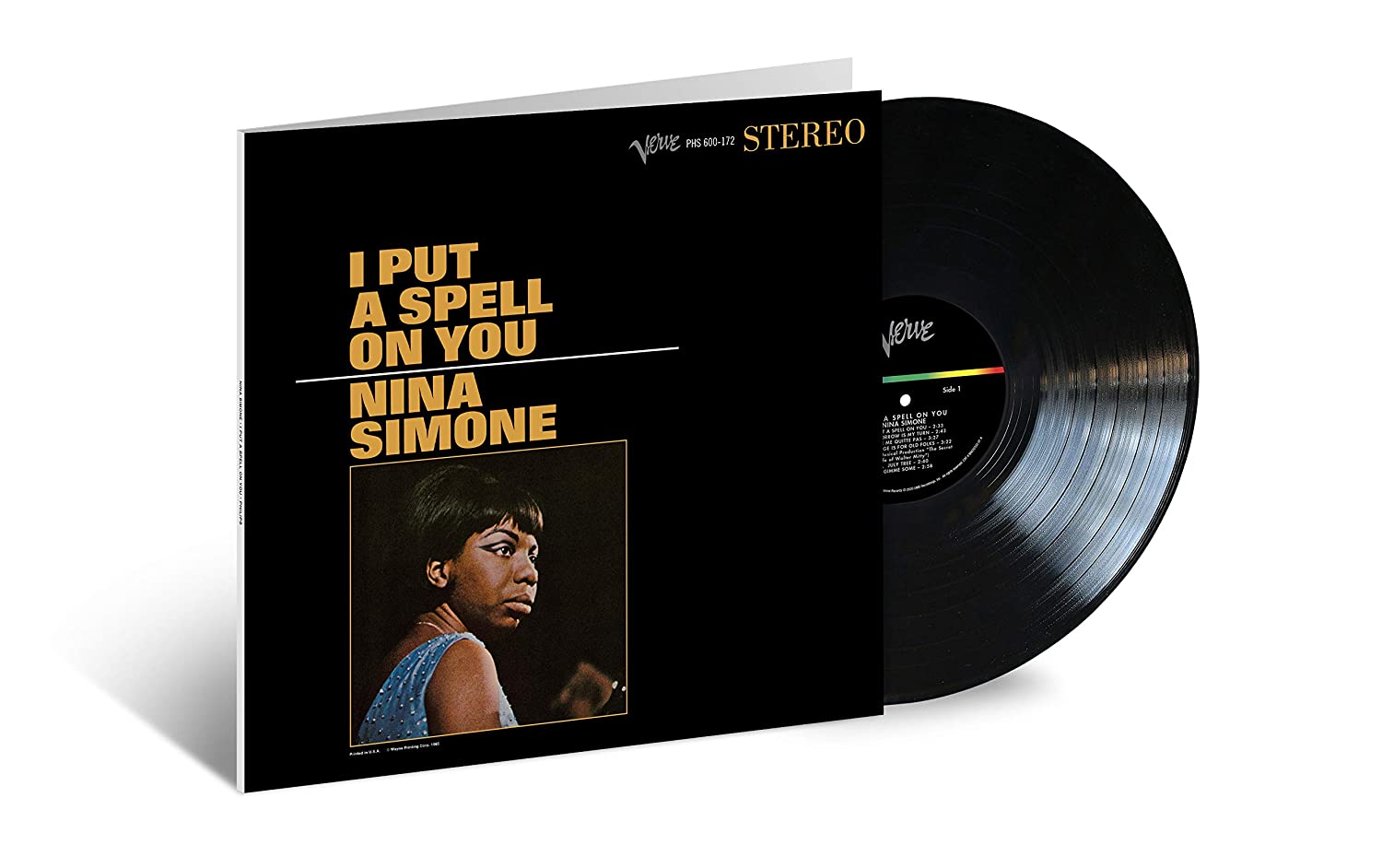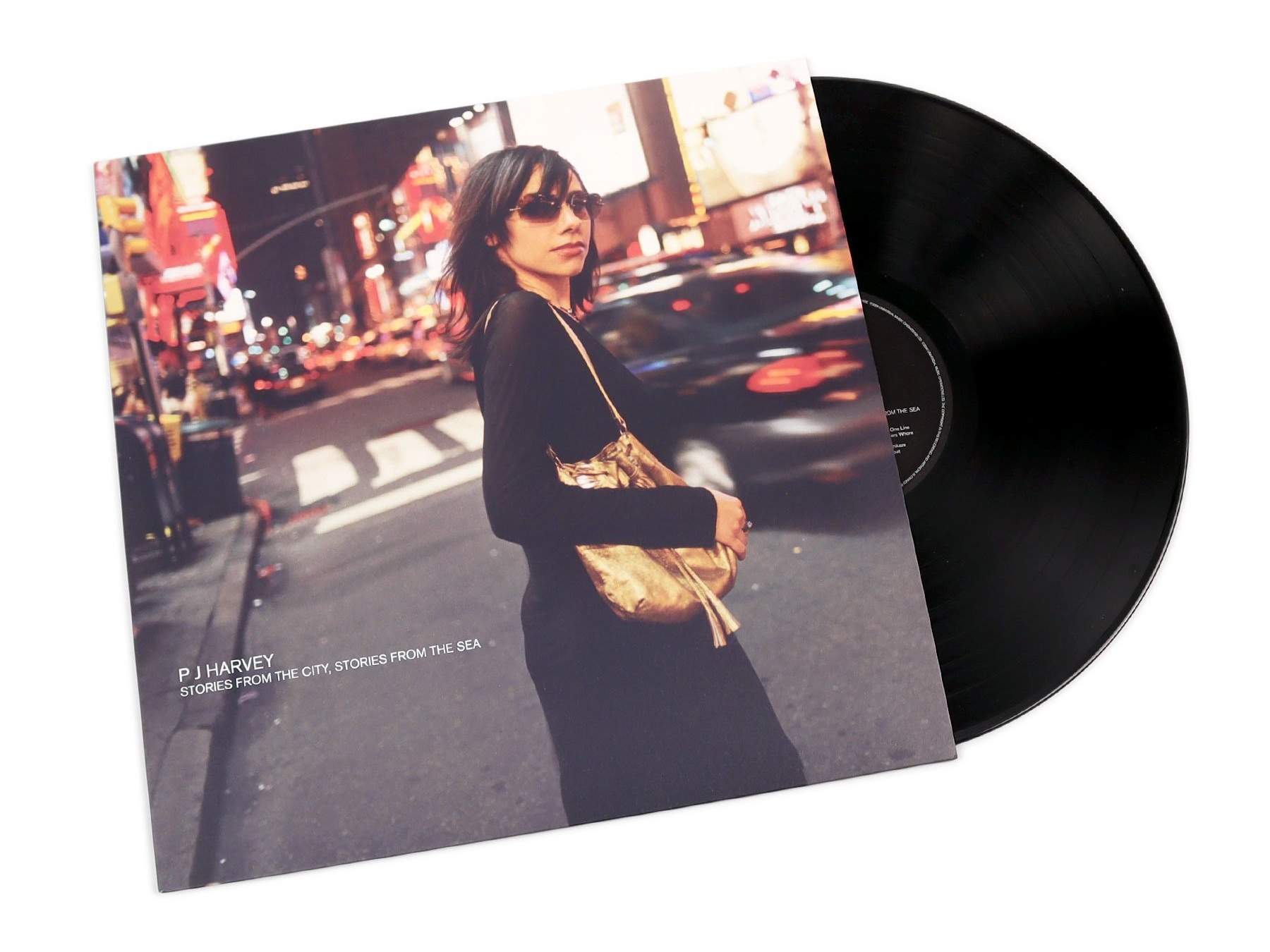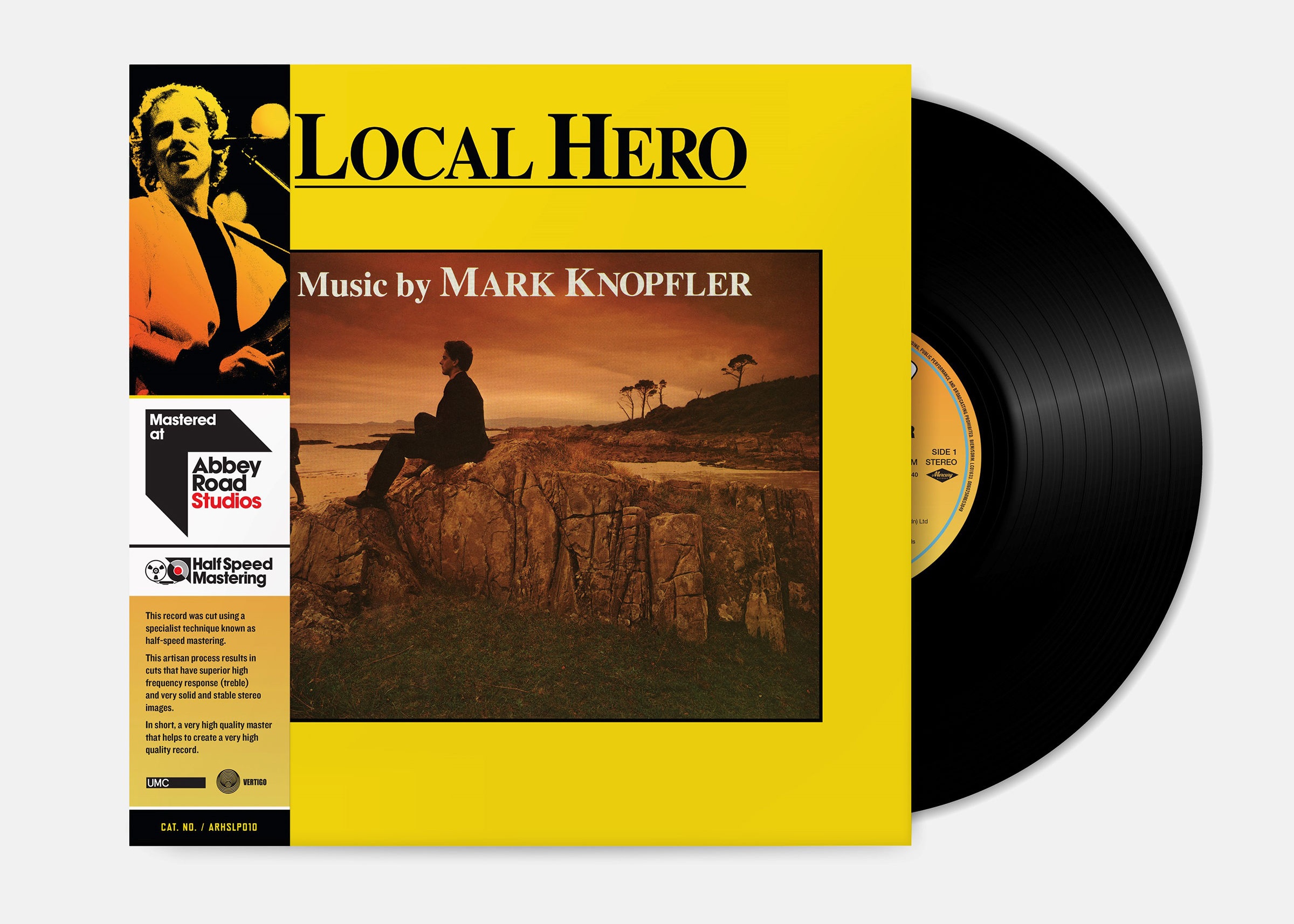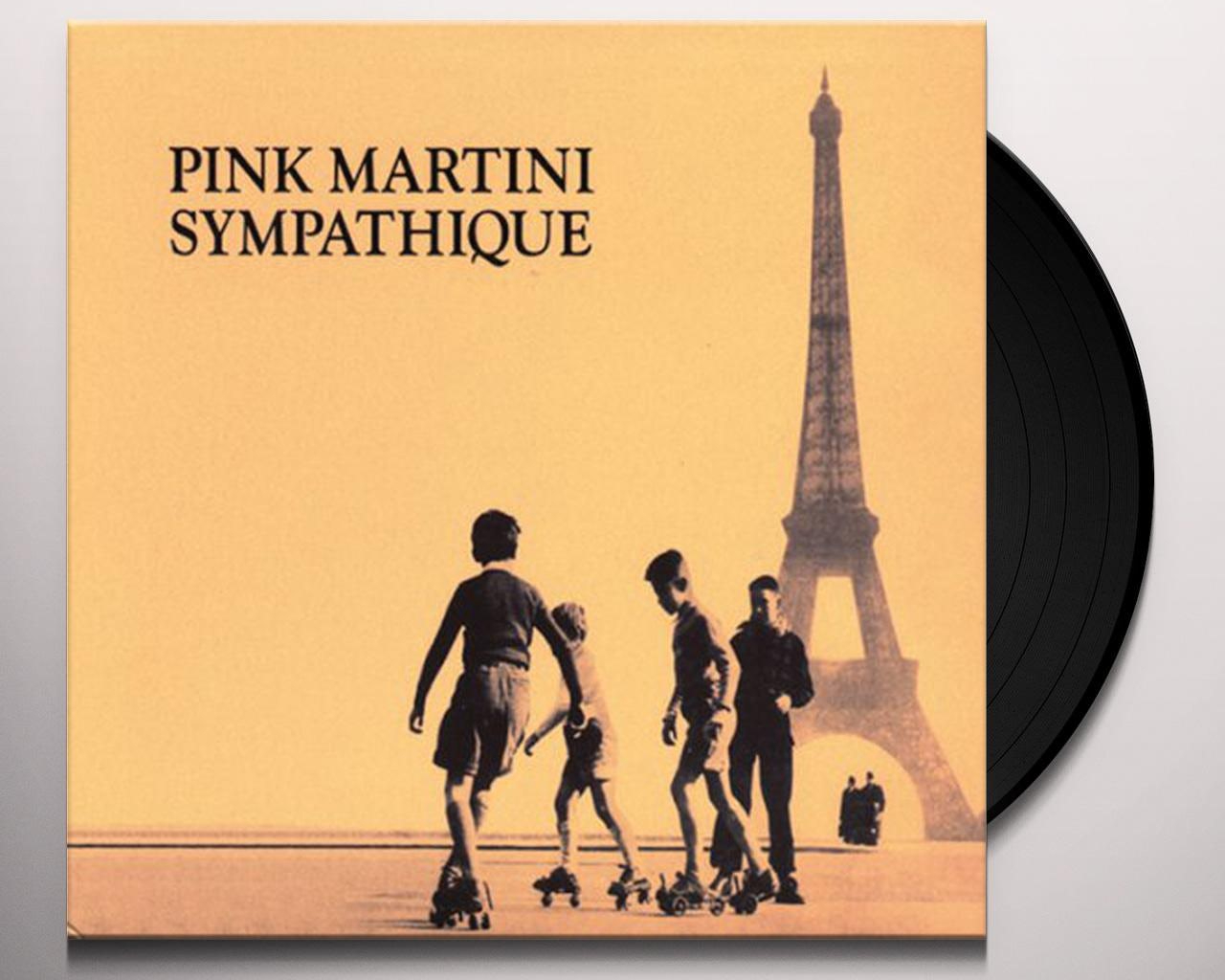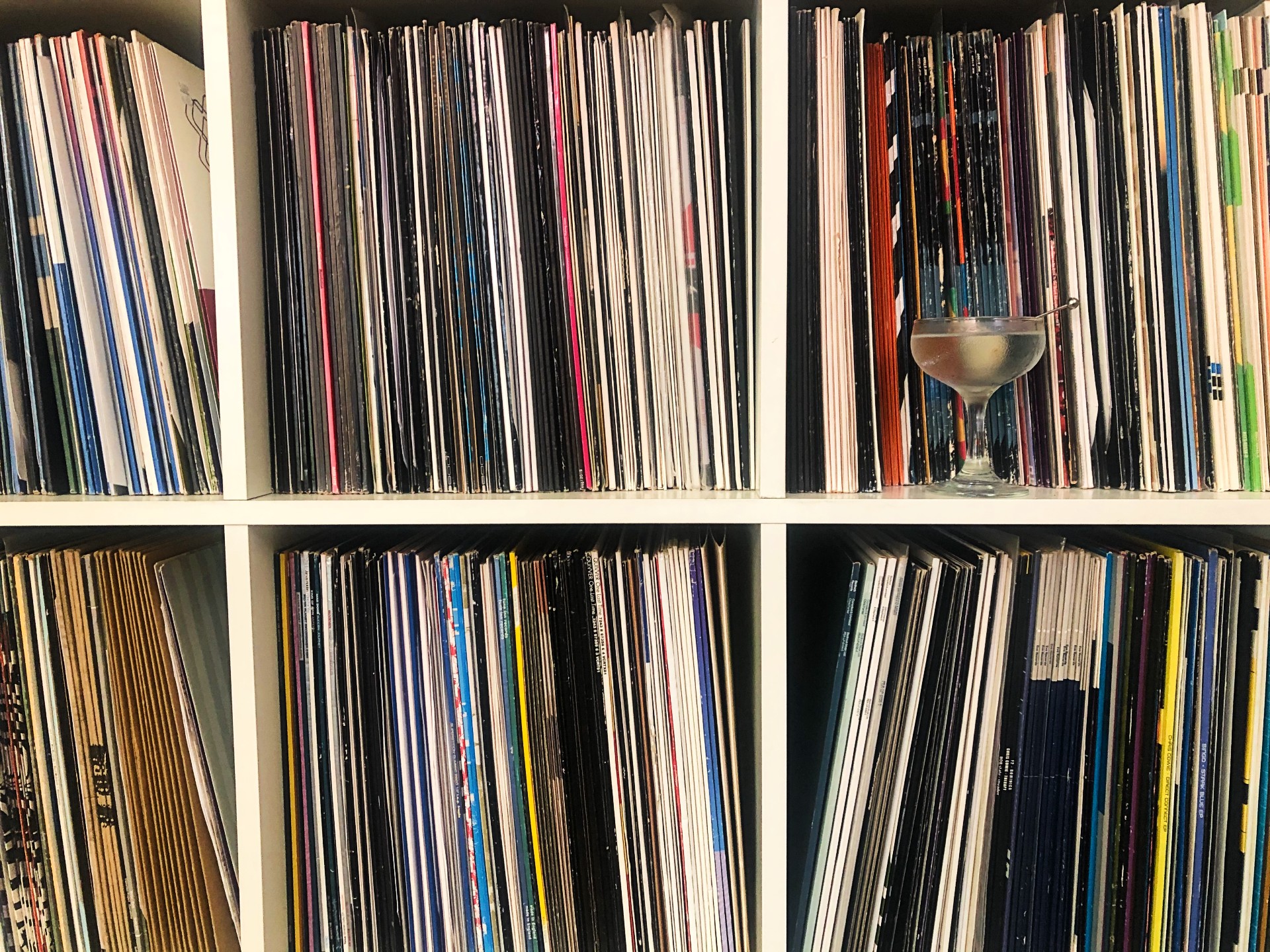
Gibson and vinyl | Photo: Daniel Djang
What a difference a year makes. As this post goes live, more than 140 million Americans have received their Fauci Ouchies and are fully vaccinated. Los Angeles is fully reopening on June 15, which means we can finally bend an elbow inside bars and restaurants.
Inspired by the excellent Booze and Vinyl cocktail book by André and Tenaya Darlington, I’m putting the band back together for another Deep Cuts post. As before, music nerds from the bar industry select an album and pair a couple of cocktails to enjoy while listening to it. The guest writers will also spotlight a nonprofit that they support.
Starting with a Black Music Appreciation Month pairing from yours truly, read on and enjoy a wonderfully eclectic mix of music and drinks. Support independent record stores, and cheers to going to concerts and dancing to DJs IRL.
Nina Simone – I Put A Spell on You [Philips, 1965 | Verve/UMe, 2020]
Since its launch in June 2020, the Acoustic Sounds Series from Verve/UMe has been a revelation for jazz fans – audiophile reissues of essential albums that are mastered from the original analog tapes, pressed on 180-gram vinyl, and packaged in tip-on gatefold jackets. Listening to the Acoustic Sounds release of John Coltrane’s immortal A Love Supreme was simply mind-blowing – it was like hearing it for the first time. (FYI you can order 180g LPs directly from Acoustic Sounds, and there’s MUCH more in their online catalog than the Verve/UMe jazz releases – nearly 3,000 titles!)
In September 2020, Acoustic Sounds released Nina Simone’s I Put A Spell on You, her third album on Philips Records. The album opens with her cover of “Screamin’ Jay” Hawkins’ iconic “I Put a Spell on You,” and that’s exactly what she does over the span of a dozen songs. Recorded in New York City from 1964 to ’65, I Put a Spell on You was released during a pivotal time for the “High Priestess of Soul.” Her move from the Colpix label to Philips marked a dramatic shift to more political themes in her music.
Simone’s first Philips album, Nina Simone in Concert features the incendiary “Mississippi Goddam,” her response to the murder of Medgar Evers and the bombing of a church in Birmingham, Alabama that killed four Black children. Released as a single in 1964, “Mississippi Goddam” became an anthem for the burgeoning civil rights movement – going forward, political activism would be an integral part of Simone’s music and live performances.
Simone wraps her magnificent voice around a wide range of covers and styles on I Put A Spell on You, from the lush title track to finger-snapping jazz, foot-stomping blues, moody French ballads and obscure show tunes. Throughout the album, her virtuosic piano playing is accompanied by melodramatic big band-style arrangements with an emphasis on brass and strings.
In her 1991 autobiography – also called I Put A Spell On You – Simone wrote, “Critics started to talk about what sort of music I was playing and tried to find a neat slot to file it away in. It was difficult for them because I was playing popular songs in a classical style with a classical piano technique influenced by cocktail jazz.” It doesn’t get more Booze & Vinyl than that, friends.
A-Side: The Last Mechanical Art
Bookended by the swinging “Tomorrow Is My Turn” and the playful “Marriage Is For Old Folks,” Simone’s haunting cover of “Ne me quitte pas” (“Don’t leave me”) is a poignant interlude that draws you in with its understated melancholy. Written by Belgian singer-songwriter Jacques Brel in 1959 after he was dumped by his pregnant mistress Zizou, “Ne me quitte pas” has been recorded in more than 20 languages – an English adaptation, “If You Go Away” has itself become a pop standard.
To accompany this mournful French ballad, you’ll need a stiff drink as heavy as the gut punch that Brel wrote about in his song. When I hear Nina Simone’s voice, I immediately think of mezcal, a spirit that can overpower you with earthy smoke or elevate you with sweet fruit – Nina could do the same in a single verse. The Booze Fairy recently dropped off the 2020 bottling of Doba Yej, a copper pot espadín from the Siete Misterios range, and it’s a fine entry-level mezcal to feature in both of my Booze & Vinyl pairings.
In his latest book, Mezcal + Tequila Cocktails, author Robert Simonson compiles more than 60 agave cocktail recipes by bartenders from across the country, and contributes several of his own. Start your liver stretches and mix yourself The Last Mechanical Art, a bitter, stirred bruiser created by Maks Pazuniak at Cure in 2011.
The Last Mechanical Art
recipe by Maks Pazuniak, from Mezcal + Tequila Cocktails by Robert Simonson
- ¾ oz Siete Misterios Doba Yej (Simonson calls for Del Maguey Chichicapa)
- ¾ oz Cynar
- ¾ oz Punt e Mes
- ¾ oz Campari
- Stir over ice and strain into a chilled coupe.
- Express an orange twist and drop it into the coupe.
B-Side: Sweet Mezcal Martini
Side B opens with the album’s best-known cut: Simone’s incomparable cover of “Feeling Good,” originally written for a British musical called The Roar of the Greasepaint – The Smell of the Crowd. Simone’s acapella intro has been sampled numerous times, and her version is readymade for movies and TV – it will likely sound familiar even to those who don’t know much about Nina Simone.
You can go down a rabbit hole of decades of memorable covers of “Feeling Good,” from Coltrane and Sammy Davis Jr. to George Michael and Muse. In January, John Legend performed it during the Biden-Harris inauguration special, Celebrating America. But with all due respect to the many artists that have covered “Feeling Good,” there’s Nina Simone and there’s everyone else. As we start to climb out of the pandemic and the world starts to open up, the song’s hopeful lyrics resonate more than ever:
It’s a new dawn
It’s a new day
It’s a new life
For me
And I’m feeling good
The polar opposite of the A-Side cocktail, the bracing Sweet Mezcal Martini is bright and refreshing with just a hint of smoke. It’s a nod to the early years of the Martini and a great sipper for any setting this summer – poolside, pre-bbq, nightcap.
Sweet Mezcal Martini
original recipe by Robert Simonson from Mezcal + Tequila Cocktails
- 2 oz Dolin Blanc Vermouth
- 1 oz Siete Misterios Doba Yej
- 2 dashes orange bitters
- Stir and strain into a chilled coupe
- Garnish with a Dirty Sue Whiskey Cherry
Nonprofit: Art Beyond the Glass is celebrating its 10th anniversary this year! Follow ABTG on Instagram and Facebook for updates on virtual and IRL celebrations.
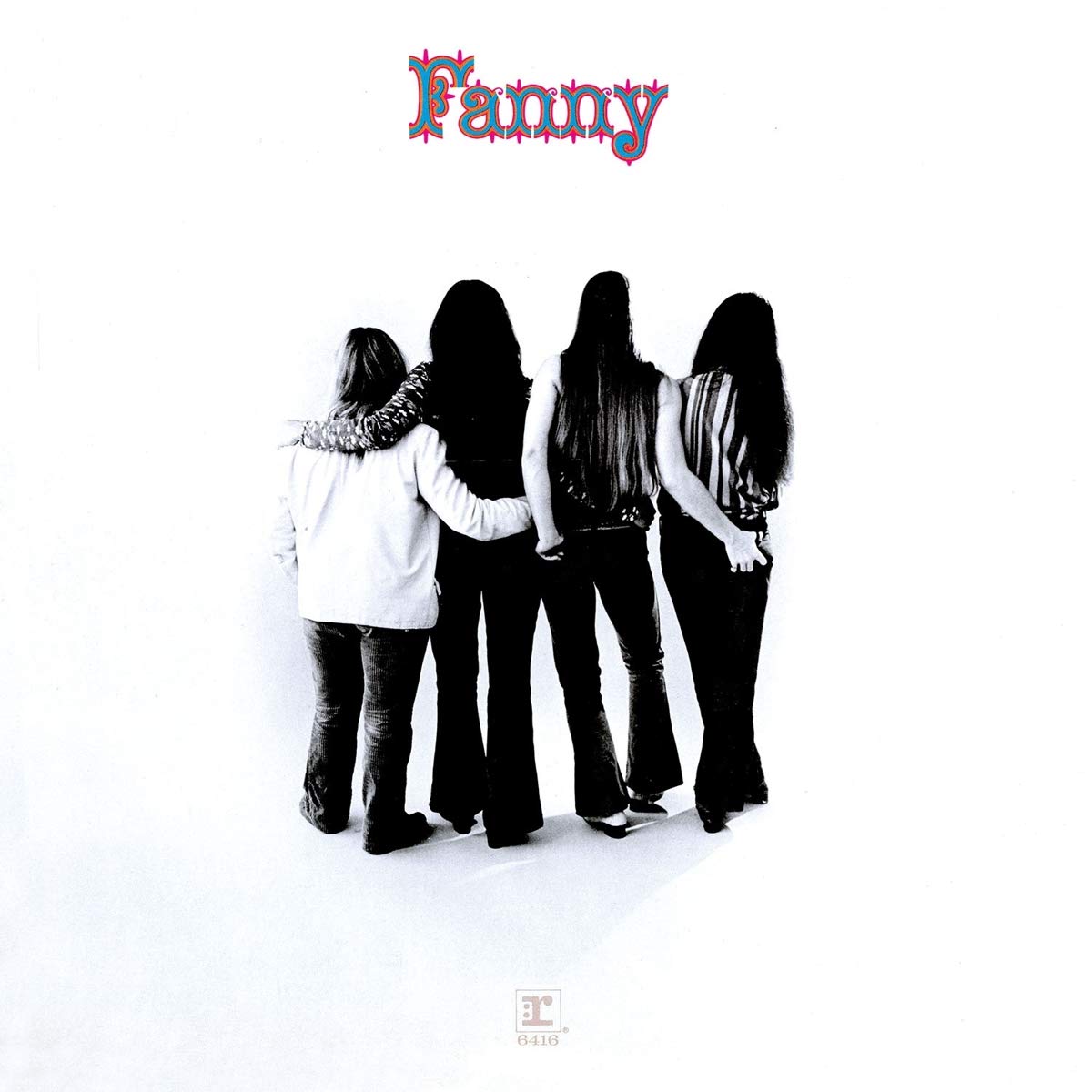
Fanny – “Fanny” | Photo: Amazon
DAVE CASTILLO
With 23 years experience in the bar/restaurant industry, Dave Castillo has been tending bar for about 19 years, became a sommelier in 2008, and delved into the classic cocktail scene in 2009 when he went to work with Jason Schiffer at 320 Main. Dave spent 5+ years in Palm Springs managing the bar at Workshop Kitchen+Bar with his partner in life Michelle Bearden, and managed Workshop’s sister bar, Truss & Twine, which he opened in 2017. Most recently he moved back to Long Beach to manage The Ordinarie with Christy Caldwell. Ever the music lover, he has sung in a band, DJed, and will take almost any chance he gets to see a live show.
Fanny – “Fanny” [Reprise, 1970]
“I have to start this out with a story I heard a couple of years ago. In the late ’90s a fan wrote a letter to Rolling Stone Magazine in which he was playing advocate for what he called one of his favorite bands. His letter read:
“One of the most important female bands in American rock has been buried without a trace, and that is Fanny. They were one of the finest fucking rock bands of their time in about 1973. They were extraordinary; they wrote everything, they played like motherfuckers, they were just colossal and wonderful, and nobody’s ever mentioned them. They’re as important as anybody else who’s ever been, ever, it just wasn’t their time. Revivify Fanny and I will feel that my work is done.”
That fan and advocate who was trying to get Fanny their due credit was none other than David Bowie. Fucking David Bowie!
The band was formed in the late 1960s by teenage sisters Jean Millington (bass and vocals) and June Millington (guitar and vocals); along with Alice de Buhr on drums, and went by the name Wild Honey. They had been performing at local teen centers and school dances, then open mic nights and small gigs. Later whilst playing at The Troubadour they were noticed by producer Richard Perry’s secretary. He listened to them and decided they needed to be recorded. With the addition of Nickey Barclay on keyboard and vocals, they renamed their band Fanny and began recording in early 1970.
What made Fanny awesome was the fact that they were so many “firsts.” They were the first all-female “rock band” signed to a major record label with a multi-album deal; they were formed by immigrant sisters from the Philippines; they were openly gay or bi; they were the first female rock band to achieve Top 40 success on the Billboard Hot 100; and their influence on future bands was immense, though largely unnoticed. So many people think The Runaways were the first successful all-female rock band for all the reasons, however once Fanny had landed in LA and taken “The Strip” by storm, Kim Fowley (creepy fuck that he was) went into their dressing room after a show at the Whiskey A Go Go, and told them that he’d just had this bright idea – ‘I’m going to form a band like yours, but we’re going to make money.’ A few years later Fowley did just that – he founded a group of teenage girls, exploited their jail-bait sexuality, and made them stars.
Fanny did achieve some success and rubbed elbows with the likes of The Rolling Stones, David Bowie, Bonnie Raitt, Slade, and Humble Pie. They were more commercially successful in Europe, but by 1975 – for many reasons I won’t go into because I’ve already written too much about the band and not the album – I will once again quote Bowie and settle on “it just wasn’t their time.””
A-Side: Tasty Waves
“This is one of those drinks I came up with out of necessity because the bar I took over had a lot of stuff I never would have ordered. Things like 14 bottles of Malibu and even more Jägermeister. I’m old enough to remember the Surfer On Acid, a lousy drink from the ’90s that was simply those two spirits and pineapple juice, shaken, and dumped into a glass. It sucked, but a 20 year old me could stomach it and it got me drunk. Years later I realized it was essentially a tiki drink – a bad one, but a tiki drink. This is the third time I’ve improved it now. Being that it is exotic, yet familiar, it goes with this album well.”
Tasty Waves
(“because “Surfer” and Jeff Spicoli”)
- 1 oz Malibu
- ¾ oz Jägermeister
- ¾ oz Rum Fire
- ¾ oz Pineapple Shrub
- 1 oz lime juice
- Combine all ingredients in a tin, shake with crushed ice, dump into Hurricane Glass, garnish with pineapple wedge and parasol. Drink!
Now this is a tiki drink!
This album starts out with “Come And Hold Me,” the girls exclaiming in the first line “Come on and see me, baby!” What a brilliant first line of a first album by a group of young girls at that time! It’s fun and breezy, full of acoustic guitar, percussion, and really sets the mood. Or so you think, because “I Just Realized” is more of a funk song with the heavy bass, fuzzed out guitar by June that sounds like Lennon or Clapton, and Nickey’s piano and vocals. Their track “Candlelighter Man” shows the respect and influence of the Motown sound. Good handclaps too (I’m a sucker for them).
“Conversation With A Cop” is one my favorite tracks of the album. I listened to it over and over during the initial shutdown and was blown away by how appropriate it was for the time. Barclay sings: “I only wish that I could tell you, but I haven’t any reason to be out when every place is dark I’d only like to flee the light you’re shining in my face I’ve done no wrong; I’m just looking for some place to walk my dog.”
The last track of Side A is the first of two covers on the album and a bold one at that! Covering Cream’s “Badge” (co-written by Eric Clapton and George Harrison) itself was bold, but speeding up the tempo a little and June rocking the shit out of the guitar solo that would have made Clapton take pause. This may be a better version. That’s not the cocktail talking! Speaking of, time for another one.”
B-Side: Boilermaker
“I love a good Boilermaker. Don’t judge me, with a little thought put into the pairing, a beer and shot can be awesome. It gives you options – you can shoot the whiskey and chase it with the beer, you can take a couple sips of the beer then pour or drop the shot into the glass and drink it as fast (or slow) as you want. I also love a Boilermaker because of its defiance in the face of all those silly notions about the order in which you’re supposed to drink – beer before liquor, liquor before, whatever. Drink what you want, in the order you want, just try not to drink too goddamned much!
For this Boilermaker I’m doing a pilsner by Chapman Crafted Beer in Orange, and a shot of E.H. Taylor Single Barrel. The slightly hoppy but easy drinking pilsner, with its malty breadiness goes perfectly with the bold, spicy bourbon. It seems rock and roll to me, and more rock and roll is to come.
The second side of the album opens with “Changing Horses.” It starts out with a subdued piano intro that may evoke a smoky card room, full of guys, from a black and white film, then turns into one of the most rocking songs on the album. June’s driving base, Jean’s raging guitar, Alice killing it on drums, and Nickey’s straining voice screaming “In the beginning, it was easy, it was right! You wouldn’t leave me alone, stay out all night!” Who among us hasn’t felt that before? It calls for a sip of that bourbon. Followed by a sip of pilsner. Delicious!
“Bitter Wine” is a remorseful ballad with some of the best vocal arrangements on the album, but with a great outro full of awesome electric piano. Almost as if to show ‘we can do that too,’ the next track “Take A Message To The Captain” is an absolute country song with lots of slide guitar and piano that evokes Brits doing country a la Rolling Stones. “It Takes A Lot Of Good Lovin” is the second cover of the album. Originally released by Judy Clay a few years before and also a great track. Fanny takes this soul song and spins it into R&B/rock awesomeness.
“Shade Me” mixes R&B and a Latin, boogaloo sounding piano with what sounds like Nickey doing her best Aretha. I’m down to about half of my beer and half-shot of bourbon, so I am going to drop the shot in the beer and finish it off during this last song because it’s a fiery one! Vicious, driving, metal guitar, pounding drums, one badass solo by June followed by one from Nickey. They do not let you down easy, opting to instead close with a FUCK YEAH!”
Nonprofit: “I’d like to choose 4ocean, as apparently it is National Ocean Month and they’re fucking dirty!”
BRYAN CHENAULT
Bryan Chenault is the Brand Development Director/Owner of conspiritor consulting, which represents Amaro Angeleno, Ventura Spirits, and East Imperial tonics. Listening to records at home helped him get through the pandemic, but he really really really can’t wait to see live music around other aging indie rock nerds in small- to medium-sized venues again.
PJ Harvey – Stories from the City, Stories from the Sea [Island, 2000]
“As a devoted disciple since her debut Dry dropped in 1992, it’s difficult to know where to start about how much I admire and idolize Polly Jean Harvey, all-around badass and underappreciated icon, but here goes.
Having first made her mark with raw, howling, sparse, lo-fi blues rock — further perfected on her sophomore effort Rid of Me (1993) — it took till the year 2000 to deliver her most heartfelt, fully realized, and best produced (read: slickest) album to date, which feels just as fresh and crisp 20 years on.
Released less than a year before 9/11, Stories from the City, Stories from the Sea finds PJ in an unfamiliar headspace of urban peace, with her fifth album equal parts uncharacteristic look at love requited and ode to New York (where she lived and recorded for a six-month stretch), the city both her muse and backdrop for what at least appear to be happier times.
Winner of the 2001 Mercury Prize (UK Album of the Year), Stories… juxtaposes downtown skyscrapers with the Dorchester countryside (her coastal home), from England to America, and past loss turned “This is love love love.”
While not her deepest lyrical work, it stands as the most refined and complete collection of songs in her canon. The piss and vinegar from early albums is still ever-present (the best example being the machine gun drums that build into a punk onslaught in “Kamikaze”), but this time around it’s balanced by admissions like “It’s the best thing / A beautiful feeling.”
With her maturity as a musician and comfort in her own skin comes a more measured approach: a focused, near flawless album that grabs you from the first pulsing notes and doesn’t let go until ethereal ender “We Float.” [Note: Stories… was reissued on vinyl in February 2021. ~ Ed.]
In sticking with the dichotomy of the album’s across-the-pond inspirations, and in trying to mirror this new turn of mostly light subject matter set against her trademark rough-and-tumble guitar riffs, I picked a pair of drinks that are brown spirit-based, but bright: one made famous in NYC and another invented overseas.”
A-Side: Old Pal
From the upbeat but tamed guitars of album opener “Big Exit,” you can tell this is a different kind of PJH record. With sweet nothings like “Baby, baby / Ain’t it true / I’m immortal / When I’m with you,” it’s clear we’re in for a kinder, gentler Polly. That unexpected positivity bleeds into track 2, with its mention of “My bad fortune slipping away / And I feel the innocence of a child / Everybody’s got something good to say.” “A Place Called Home” doesn’t let up on that optimism, portending how “One day, I know / We’ll find a place of hope / just hold on to me.”
At this point, the Old Pal has done its trick, starting out delicate and pretty, until that rye slap on the shoulder starts to sting, which after a pair of dirty, girl-and-a-guitar dirges — both made eerie by Thom Yorke’s background wails — manifests in Side 1 closing CRACKER “The Whores Hustle and the Hustlers Whore,“ all crunchy guitars, throbbing bass, painful shrieks, and couplets like “Speak to me / of heroin and speed / Of genocide and suicide, of syphilis and greed.”
Old Pal
credited to Harry MacElhone (of Harry’s New York Bar in Paris)
- 1 oz Rye Whiskey (“to stick with the UK theme, let’s use East London Liquor Company’s London Rye”)
- 1 oz Dolin Dry Vermouth
- 1 oz Campari
- Combine, stir with ice, strain into a chilled coupe, garnish with an orange peel.
B-Side: New York Sour
“While the first half of the record ends with a veritable slap in the face, the flip side immediately warms with “This Mess We’re In,” a duet with Yorke, where Thom takes the falsetto lead and PJ provides reassuring spoken word interplay.
There were any number of drinks synonymous with New York that I could’ve picked, especially as later on “You Said Something,” she sings of “A rooftop Manhattan / One in the mornin’”, but the repeated chorus of “The city sun sets over me” had me thinking of a cocktail that captures the colors of dusk, and a New York Sour seemed a perfect fit. (Also, it can look of a “mess” on paper, but like the song and their performance, is a delicious harmony that we didn’t know we needed until they were paired so beautifully together.)”
New York Sour
by unnamed Chicago bartender, late 1800s
- 2 oz Hudson Bright Lights, Big Bourbon (formerly Hudson Baby Bourbon)
- 1 oz lemon juice
- ¾ oz simple syrup
- 1 egg white
- ½ oz red wine (preferably Pinot Noir)
- Combine and shake, strain into a rocks glass over ice, pour red wine over the back of a bar spoon to float.
Nonprofit: Skid Row Housing Trust
CHUCK TAGGART
Chuck Taggart moved to Los Angeles from New Orleans in 1982 to go to film school, and has been here ever since. Amid working at HBO for 30+ years he also found a side career in public radio, having DJed at KCRW and KCSN from 1988-2008, and fell into cocktail nerdistry in the late ’90s. His now-undead weblog Looka! evolved into one of the early cocktail blogs way back when. He still drinks and listens to music, especially during daily listening to WWOZ. His radio show, Safe at Home streams live every Saturday at 1pm Pacific and is archived at Mixcloud.
Mark Knopfler – “Local Hero” Half-Speed Remastered [Vertigo / Mercury Import, 1983 / 2021]
“For 38 years, Local Hero has been my all-time favorite film. (It’s had some competition from “Serenity” in 2005 — “I aim to misbehave.” — and sometimes they’re tied, but mostly not.) Bill Forsyth’s gorgeous, charming, subtly to hilariously funny, sad and ultimately hopeful movie offers more joys every time I watch it; the last time was quite recently, thanks to a terrific new Criterion Collection Blu-ray release.
It’s the story of McIntyre, aka “Mac” (we never learn his first name; played by Peter Riegert), a Houston, Texas oil company representative who’s sent to Scotland at the behest of the company’s eccentric CEO Felix Happer (Burt Lancaster) to acquire a large swath of real estate, an entire town, to be razed for a huge new oil refinery complex. Happer chooses Mac in particular because of his Scottish heritage, but as Mac confesses to a co-worker, “I’m not Scottish. My folks changed their name when they arrived from Hungary. They thought McIntyre was American.”
Mac arrives in the stunningly beautiful village of Ferness with a young Scottish employee of his company (played by an impossibly young Peter Capaldi), ready to close a deal in a few days, get it over with and come home. But he gradually falls in love with the place and its people, and has second, third, and fourth thoughts about whether this deal is the right thing to do. Meanwhile, the townsfolk are pretty much only thinking about one thing: “Ohhh boy… are we going to be rich,” and cannily try to jack up the sale price.
My description doesn’t really do the film justice — please just see it.
Mark Knopfler’s music for the film has been one of my very favorite soundtracks ever since, starting off twangy for Texas but then beautifully evocative when moving to Scottish Highlands, with a recurring theme that makes my scalp tingle, and I close my eyes and gently sway whenever I hear it. The fantastic news I heard early this year was that for the first time the original master tapes, which had been “locked on two obsolete digital formats for which there are very few working machines left to recover the audio” and thought to be unrecoverable, were deciphered due to amazing detective work and brilliant remastering by Abbey Road Studios sound engineering whiz Miles Showell. The result is a half-speed mastered vinyl LP, the first release since 1983 of some of the best music Mark Knopfler has ever written, from its original source. And it sounds fantastic. Audio nerds can geek out on the details here.”
A-Side: Ranch Water
“Side 1 starts us, as the film does, with Mac at work and home in Houston, so I tried to think of what might be a quintessential Texas cocktail (Mac’s early-generation digital watch has a tinny, off-key electronic alarm that plays “The Yellow Rose of Texas”). That would likely be a Paloma, which I love (and which you certainly may make while listening to this if you like!), but I thought about offering something that might be a bit less well-known.
Recently in Punch I read an article about “the unofficial cocktail of West Texas” called Ranch Water, which I must confess I’d never heard of. In its most basic form it’s just a Tequila Rickey — tequila, lime juice, and soda (in this case Topo Chico, of course). I’m trying to cut down on sugar these days so Gin Rickeys have been one of my summery drinks of choice, and this sounded right in my wheelhouse.
Over the last few years a number of of Texas bars have been putting their own spin on this drink, gussying it up a bit while remaining true to its roots and simplicity. I think of the versions I read about, the one I like the best is from the bar at the Gage Hotel in Marathon TX, whose White Buffalo Bar had been serving it for many years. A little over 10 years ago they officially added it to their cocktail menu, adding orange liqueur for depth of flavor (this moves it from being a Tequila Rickey to being kind of a rebalanced fizzy Margarita) and doubling the typical amount of lime juice. The latter appeals to me as well, as I like my citrus drinks tart AF these days.
(Yes, I know Houston is not in west Texas. If you’re going to get persnickety about geography, try Bobby Heugel’s Margarita.)”
Ranch Water
As served at the Gage Hotel in Marathon, Texas
- 1½ oz blanco tequila
- 2 oz fresh lime juice
- ½ oz orange liqueur
- 4 oz Topo Chico sparkling mineral water
- Add tequila, lime, and orange liqueur to a shaker with ice. Shake and strain into a tall ice-filled glass and top with Topo Chico. Garnish with a lime wedge.
“The bar recommends a Mexican triple sec called Pura Vida Naranja, but at home I used Pierre Ferrand Dry Curaçao, as it was what I had on hand. It works very well.
Refreshing AF for a warm-to-hot Texas or Southern California summer day!”
B-Side: Smoking Jacket
“Once we’re well into Scotland on Side 2, with Mac falling in love with Ferness and not really wanting to think about Texas anymore (the symbolic shot is when he takes off his digital watch and leaves it on the rocks to gather shells at the beach, then the tide comes in and drowns the watch as it sputters “Yellow Rose” for the last time). Obviously we need a Scotch whisky-based cocktail, and again I didn’t want the obvious — not a Rob Roy or a Rusty Nail.
My husband Wesly Moore (who works at Bar Keeper in Silver Lake) suggested something I’ve never tried, which is also the kind of drink we both enjoy — a Scotch spin on a Black Manhattan. This is perfect for Side 2 — a very Scottish base, preferably one from the Highlands where the film is set, with the addition of complex flavor elements depicting how bittersweet his experience is in Ferness. He loves the place but knows he has to go back to Houston and really doesn’t want to. In fact, late in the film when Mac is drunk not on the 42-year-old whisky he was offered earlier but “four 8 year olds and a 10 year old,” he offers to trade places with Gordon, the local hotel owner he’s befriended. He offers Gordon his condo and his Porsche (“nothing to pay on it, it’s pure ownership”), and his job (“eighty thousand a year, and thirty thousand in mixed securities”) in exchange for his getting to stay there, take over the hotel, and do “bits of business.” Oh, and he wants to keep Gordon’s wife Stella, as he’s fallen in love with her too.
This drink calls for a blended Scotch, which would work just fine (I’d recommend Shackleton Blended Malt, which is based on a Highland whisky), but as gaz regan taught us, don’t be afraid to use a lovely aged single malt whisky in a cocktail. Try a Highland single malt to evoke the beaches and hills of Ferness, and their amazing sky. Macallan, Glenmorangie, Dalmore, or one of my favorites, Oban 14.”
Smoking Jacket
by Paul Manzelli, Craigie and Bergamot, Boston MA
- 1½ oz Scotch whisky (“suggestions: Shackleton Blended Malt Scotch Whisky, or a Highland single malt, or your choice”)
- ¾ oz Cynar
- ¾ oz sweet vermouth
- 1 dash orange bitters
- Stir with ice and strain into a rocks glass with a big cube or sphere. No garnish specified.
“Complex flavor, notes of smoke and cocoa, bitter and sweet nicely balanced.
Of course, if you do have a 42-year-old whisky on hand, by all means drink that while listening.
Also, feel free to knock back a shot of Jewel of Russia vodka or whatever Russian vodka you prefer, in honor of fishing boat captain Victor Pinochkin, the regular visitor to Ferness who comes in for the cèilidh.
Now, get your jacket off. We’re waltzing.”
Nonprofit: The Trevor Project
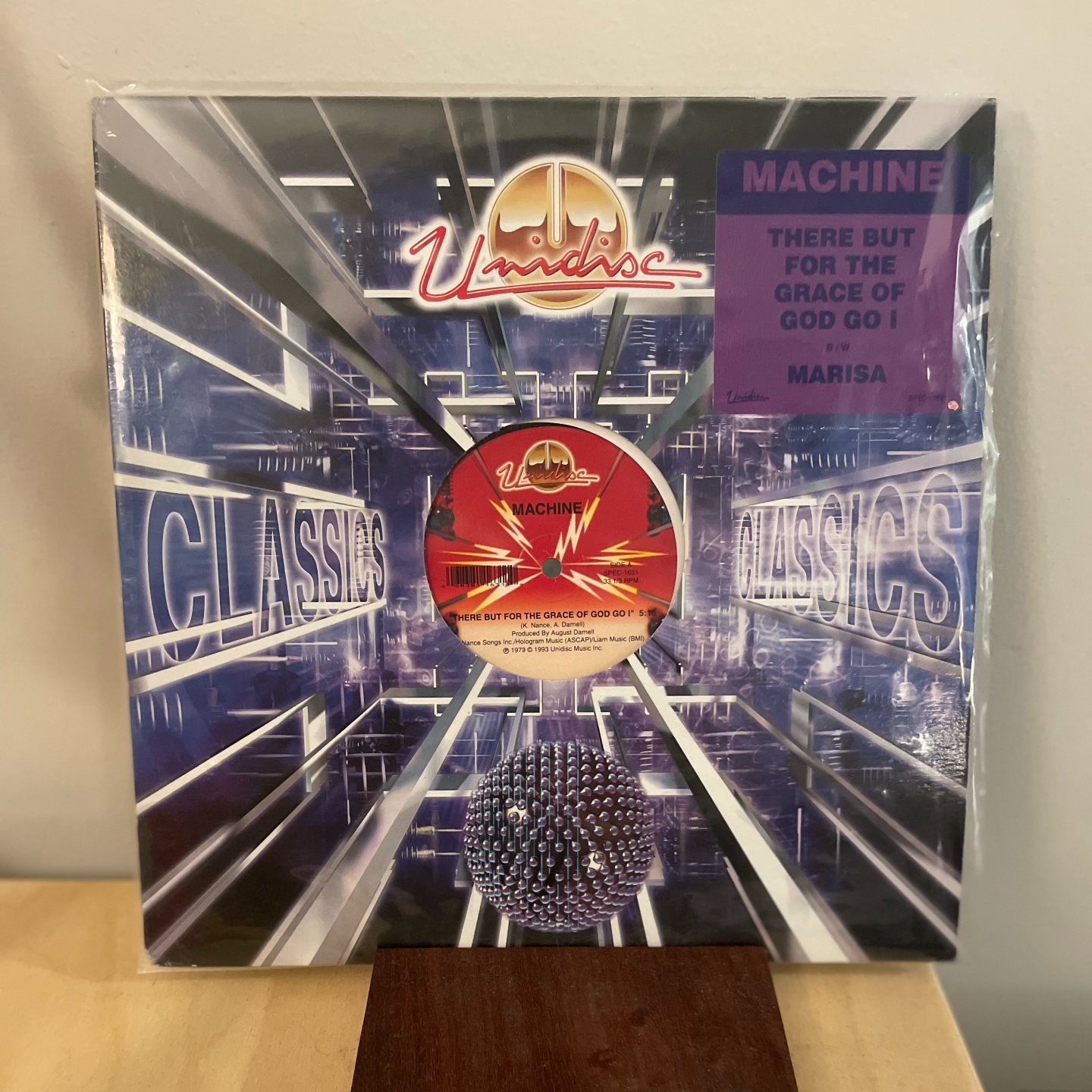
Machine – “There But For the Grace of God Go I” | Photo: Colin Miller
COLIN MILLER
Colin Miller is the LA District Manager for Campari America and DJs around town at spots like Club Tee Gee, 82, Lowboy, Broken Shaker and Resident. Along with Dances With White Girls and Marlos he is a resident of the Spritz filled day party Vacay Mode (@vacaymodela on IG) as well as collaborating with LA legend Thee Mike Bee on the monthly classic dance music party I Feel Love (@ifeelovedisco) at Club Tee Gee. When he’s not selling booze you can often find him at LA’s best record store, Paradise City in East Hollywood looking for ’90s House 12″s or scouring the $1 bins at Record Jungle in Whittier.
Machine – “There But For the Grace of God Go I” [RCA, 1979]
“As the world reopens, the nightlife creatures awaken from their slumber, and we all try to figure out how we’re gonna pack into sweaty rooms and dance as soon as possible – I was trying to think of some foundational records that I reach for without fail to get a crowd moving. This track was originally released in 1979 by Machine, who scored a minor hit with it initially but never repeated this success – they eventually broke up after their second album. One of the members, August Darnell went on to found seminal Downtown NYC art weirdo band Kid Creole and the Coconuts.
“There But For the Grace of God Go I,” however would live on as an absolute dancefloor monster anthem, thanks in no small part to the queer club scene in post-disco NYC embracing the track, and legendary DJs like Nicky Siano, Larry Levan and David Dipino rinsing it nightly. This brings me to my oft-repeated friendly reminder that pretty much all the dance music and culture you love today came from queer (and mostly Black and Brown) artists and we owe them a huge debt of gratitude and reverence (so maybe start thinking about that when you book parties my CIS white male DJ brethren).
The driving bassline, handclaps, perfect disco synths, and soaring gospel-like vocals form a perfect cocktail of the best elements of the early dance music culture being formed on dancefloors in the late ’70s (Read Tim Lawrence’s two seminal books Love Saves the Day + Life and Death on the New York Dance Floor for a deep dive into my favorite musical era). “There But For The Grace of God Go I” is a rare song that can kill in a warmup set, during prime time or when you’re just dancing solo in your living room like a whacko after being in your house for 14 months. It’s also a notable track to me in that it’s great all the way through on a dancefloor, and it even spawned an equally amazing House remake by Heller + Farley under their Fire Island moniker in the 1990s (I’m pretty sure I play the Roger Sanchez version of that one in almost every I Feel Love set I’ve done). Damn – all this dance music talk and now I’m really hyped to play some music and drink cocktails with actual humans again!”
A-Side: Thunderbolt’s Espresso Martini
“Before a big night out you need that ENERGY for the dance floor so this cocktail from draft cocktail wizard and all-around amazing human Mike Capoferri has that kick of:
- Counter Culture Cold Brew
- Skyy Cold Brew Flavored Vodka (“Yeah its 2021, we can admit we like flavored vodka you nerds”)
- Sherry
- Demerara Syrup
It’s served on nitro in a can which makes it perfect for slamming on the walk to the club, waiting in line to get into Club Called Rhonda, or on Thunderbolt’s wonderful patio before you disappear into the nightlife ether to make wonderful/terrible decisions.”
B-Side: Mezcal Negroni
“When I’m DJing I rarely drink real cocktails – first of all the bathroom line is always super long and you don’t want to be the asshole who spills a sticky giant cocktail on the $10K booth setup. But if I’m going to drink something nice and the bar is not super slammed (because if you order stirred drinks in a busy club setting and you’re drinking on the DJ tab that’s a sure way to be loathed by the bar staff) I usually grab a Mezcal Negroni.”
Mezcal Negroni
- 1 part Montelobos Mezcal Espadín
- 1 part Cinzano 1757 Vermouth di Torino Rosso
- 1 part Campari (“Yes I am a corporate shill, but it’s not a Negroni without it in my eyes”)
- Stirred and served over rocks with an orange twist or slice.
Nonprofit: No Us Without You
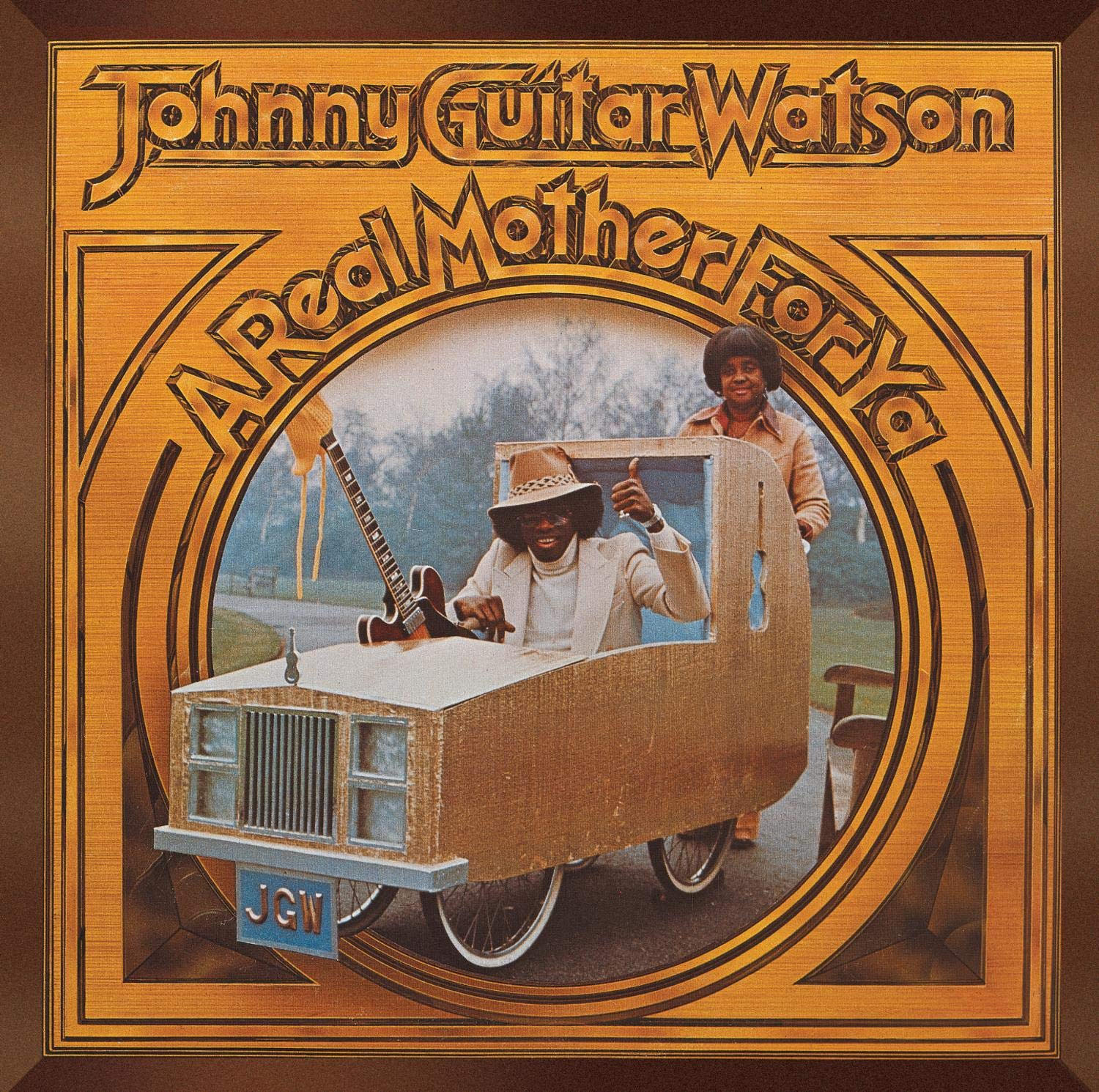
Johnny “Guitar” Watson – “A Real Mother For Ya”
DAVE STOLTE
Design director and award-winning illustrator Dave Stolte heads the studio Wexler of California, providing creative services to the restaurant, bar, and liquor industries. Clients have included Disney, Pernod Ricard, Campari America, Marnier Lapostolle, Rémy Cointreau, Smuggler’s Cove, The Bon Vivants, Lush Life Productions, Haas Brothers, Las Joyas del Agave, Dirty Sue, and Consortium Holdings (San Diego).He is the author, illustrator, and publisher of Home Bar Basics (and Not-So-Basics), twice nominated for a Tales of the Cocktail® Spirited Award as “Best New Cocktail Book,” now available in an all-new third edition co-authored with Jason Schiffer.
Johnny “Guitar” Watson – A Real Mother For Ya [DJM Records, 1977]
“For this year’s Record Store Day I’m sharing my love of Johnny “Guitar” Watson’s 1977 funk-blues smoker A Real Mother For Ya. It’s a ridiculously delicious slice of ‘70s excellence – made even better when you know that for this album Watson – a ‘50s blues stalwart facing a changing music scene – played and sang everything himself over multiple takes, excepting the horns and drums. I’ll be enjoying two ‘70s-inspired drinks with this one…”
A-Side: Frozen Strawberry Tom
“It’s a hot one out there, friends – get yourself cool by any means necessary. Frozen, blended strawberry drinks were common in the ‘70s, but I don’t remember gin making the slushy scene back then. The errors of the past have been corrected!”
Frozen Strawberry Tom
- In a blender, combine:
- 1 cup pebble or crushed ice
- 4 fresh or frozen medium-sized strawberries
- ½ oz rich simple syrup
- ½ oz lemon juice
- 1½ oz London Dry gin (Beefeater or Sipsmith)
- Blend on the Smoothie setting, serve in a snifter with a lemon wheel garnish.
B-Side: Jungle Bird
“Come on inside and get weird with Giuseppe Gonzalez‘s smart remix of the ‘70s bizarre late-stage tiki classic from the Aviary Bar at the Kuala Lumpur Hilton. His take is the contemporary standard, sophisticated and thought-provoking without sacrificing any of the original’s weirdness.”
Jungle Bird
- Shake with pebble or crushed ice and dump into a double rocks glass:
- ½ oz simple syrup
- ½ oz lime juice
- 1½ oz pineapple juice
- ¾ oz Campari
- 1½ oz Cruzan Black Strap rum
- Top with additional crushed ice and garnish with an orange wheel.
Nonprofit: Big Brothers Big Sisters of Orange County & The Inland Empire
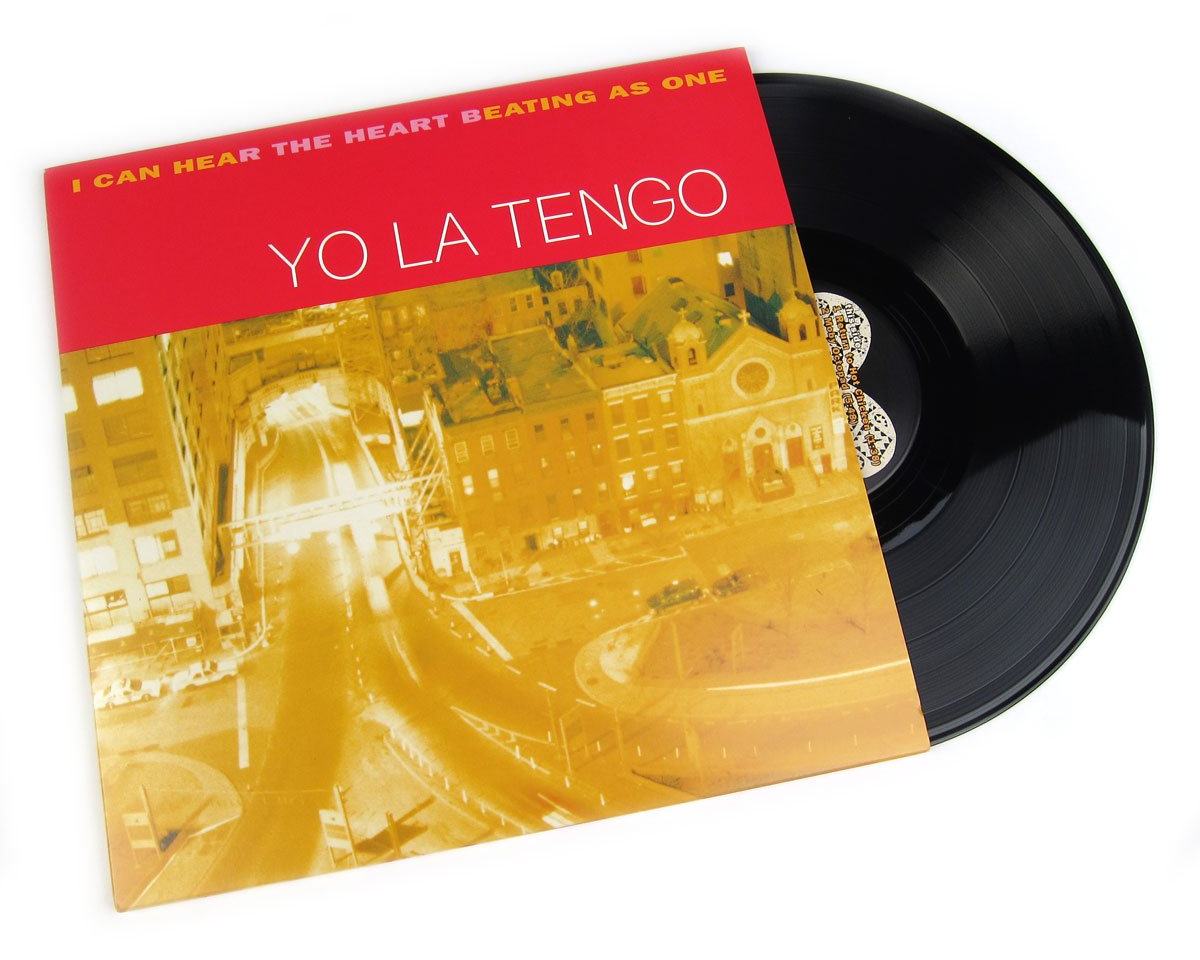
Yo La Tengo – “I Can Hear the Heart Beating as One” | Photo: Amazon
EUGENE LEE
Eugene Lee recently celebrated 10 years at Big Bar, where he met his wife Laurel and was trained and nurtured by Juan Sevilla, Dan Long, Rich Andreoli and Mia Sarazen. He’s worked with his friends and is “proudly an LA Bar Community photographer.” [Eugene is one of the best photographers in the industry, and has captured countless memorable moments for us at Art Beyond the Glass. ~ Ed.]
Yo La Tengo – I Can Hear the Heart Beating as One [Matador, 1997]
“I Can Hear the Heart Beating as One is a terrible title for an album, right? I mean, it reeks of armchair, high school poetry/philosophy; backpacking through Europe to find a ‘Before Sunrise’ moment; house party cigarettes and red SOLO Cup ashtrays; Nag Champa at the neighbor’s house (who is a self-professed witch); Rolling Rocks in the playground at midnight; of goddamn puka shell necklaces. The title is so stupid and dripping so much earnest sentiment, it can only be those years of our lives. Or maybe just mine, I don’t know.
Despite the title, the album is a near perfect encyclopedia (google it kids, they used to be real, physical things) of the music lover’s brain/heart. And that’s what I love about Yo La Tengo – they are first and foremost lovers of music. From a marketing perspective, they are the OPPOSITE of a ‘rock star/band.’ I love even more that they are older – the older they get the further they drift from anything resembling a star of anything!
BUT THE MUSIC.
Time and again, like an old friend, I turn to this album for warmth, comfort, to rediscover my own love for music. And then I’m reminded of every album each song reminds me of and go listen to those. Yo La Tengo is good like that.”
A-Side: Harvest Moon
“Return to Hot Chicken” is a good name for a new Kills single or any Jon Spencer Blues Explosion track – it absolutely is not representative of the casual and slight tropical winds that gently blow through the doors of this album, introducing the listener to what will be. That’s just the opening track, the amuse bouche. It’s short, it’s instrumental, it is a great indicator of what’s to come.
“Moby Octopad” – a train plowing through a nocturnal landscape where all the passengers are asleep and you and your pals are up and drinking and spilling Martinis while drummer Georgia Hubley, as cool as Nico, feeds another log into the train’s furnace.
“Sugarcube” – a sugary pop jam. Fuzzy guitars, Ira Kaplan’s signature lead guitar squelch – *chef’s kiss*
“Damage” – fuck, I’m destroyed. I definitely put this track in a few mix CDs I made for Laurel. With its meditative/percussive heartbeat that can only be the sound you hear if you were inside the chest of someone who is about to see the person of their dreams. It’s the scene from Big Fish where the popcorn is frozen in the air.
“Deeper into Movies” – every YLT album has a building, cathartic, guitar juggernaut – I love this track. If we are friends and we share the same outlook on life, you too love this track.
Alright, this is getting out of hand. I can go through each track, but here’s a cocktail and the dedicated track.
“Autumn Sweater” – yes, yes. You’ve heard it… somewhere. I wouldn’t be surprised if Whole Foods starts playing it every October or whatever the ‘official first day of Fall’ is. It’s as Fall-vibes as Vince Guaraldi’s Peanuts theme. [aka “Linus and Lucy” ~ Ed.] In fact, pretty sure Dan Long and I, back in [our] Mixtape Mixology days, had both the Peanuts theme and “Autumn Sweater” as our opening tracks. Anyways, the cocktail pairing…”
Harvest Moon (“yes, like the Neil Young track – also appropriately Fall AF”)
Big Bar Winter 2011 by Dan Long
- 1½ oz Laird’s Bonded Applejack
- ½ oz Amaro Nonino
- ½ oz Lillet
- ½ oz fresh pressed apple juice
- 2 dashes Angostura
- stir/strain and serve in a coupe
(“You know, I bet this would taste delicious hot – maybe with a little squeeze of lemon.”)
B-Side: Daiq 6.25.21
“Like a true Side B, the brush strokes are longer, the songs a collection that drift from one to the other.
“Little Honda” – I love this buzzy little opener, same DNA as “Sugarcube.” In their words: ‘It’s not a big motorcycle, just a groovy little motorbike.’
“Green Arrow” – The Little Honda has parked next to an ocean cliff, your helmet is off, you’re enjoying the sunset as the breeze chills the sweat on your neck.
“Green Arrow,” “One PM Again,” and “The Lie and How We Told It” are kind of a suite of chill vibes and summertime feels culminating with the beach party that is “Center of Gravity.”
This is such a reliable track for any tropical playlist – I just love it. So appropriately, I will have my current Daiquiri of choice – to be enjoyed solo or better yet, with a group of friends as a merry DTO since we can do GROUP TOASTS AGAIN.”
Daiq 6.25.21
- 1 oz Smith & Cross Jamaican Pot Still Rum
- 1 oz Clement Canne Bleue Agricole Rhum
- 1 oz fresh lime juice
- ¾ oz simple
- shake/strain and serve in a coupe
Bonus Track
“Special note: it’s almost July 4th, and while it’s usually a Modelo and mezcal day for me – I’m going to enjoy listening to the unrecognizable Grand Funk cover that is “We’re an American Band” (track 15) and drink a sparkler (i.e. Whiskey Barrel Punch).
The Yo La Tengo version is what I love about them:
- Vocals – somewhere back there
- Drums – supporting, growing, getting bold
- Guitars – storms in like THAT friend who turns a party up to 11 and things start to HAPPEN.
It’s gotta be one of my favorite guitar solos/freak outs of all time and – if guitar solos could be a physical thing – well, what else could they be besides fireworks.”
Nonprofit: The Trevor Project
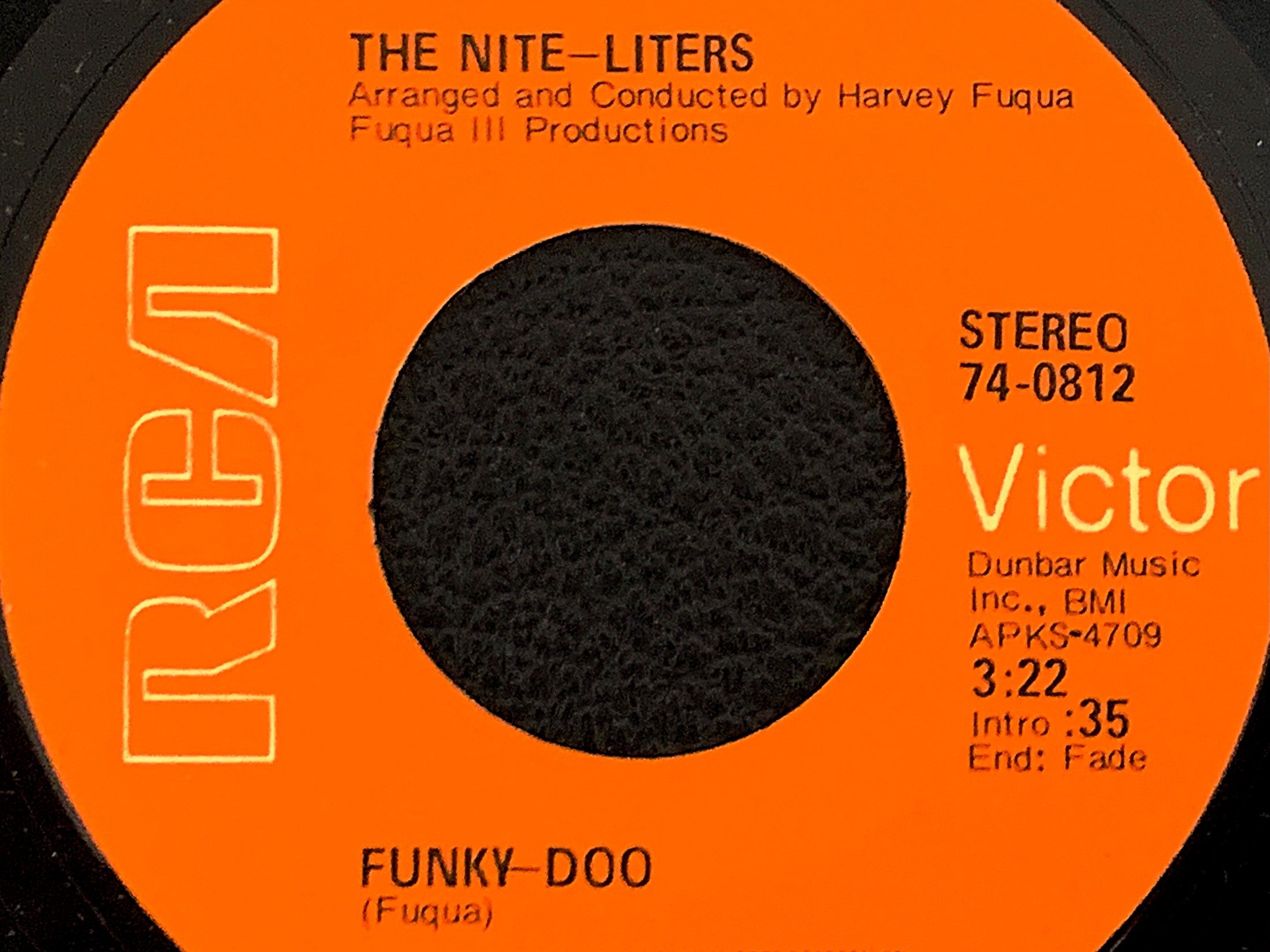
The Nite-Liters – “Funky-Doo” | Photo: Geoffrey Wilson
GEOFFREY WILSON
Geoffrey Wilson bartends at Latitude 29, works for Turning Tables NOLA, and spends his rent/food $$ on vinyl.
The Nite-Liters – “Funky-Doo” / “Do the Granny” [RCA, 1972]
“Today, I wanna talk about funk music and tropical drinks. I recently moved back to New Orleans to work at Beachbum Berry’s Latitude 29. This French Quarter hideaway has been around for six years now! In my humble opinion, there are a few things to make this place a destination spot in New Orleans: the drinks (obviously), the food, the staff, and the music. The music in this establishment isn’t just Exotica (Martin Denny, Yma Sumac, Les Baxter). There’s Jazz, Rockabilly, Electronic, Tropicalia, Ethiopian and African Funk, Krautrock, Japanese Pop, Cuban Jazz, Merengue, ’60s Cambodian Rock, Cumbia, Chanson and good ‘ol American Soul and Funk.
What makes these playlists so good – other than Mrs. Bum making them – is that her playlists and the ones I make for bars are very similar. Mine are more centered on the shit that DJs are digging for, but I don’t forget where I came from, especially when it comes to the music of my parents – although I admit Free Jazz is only for certain people (not bars/restaurants).
One of Mrs. Bum’s playlists had a dope funk instrumental by The Nite-Liters. The band was led by Harvey Fuqua, who founded the ’50s Doo-Wop group the Moonglows. They were famous for songs like “The Ten Commandments of Love,” “Sincerely,” and one of my all-time personal favourites, “In My Diary.”
In the ’60s, Harvey left the Moonglows to work for Motown, where he gave Marvin Gaye, Junior Walker, and The Spinners their start; and produced “Ain’t No Mountain High Enough” for Marvin Gaye and Tammi Terrell. Harvey later went on to discover Sylvester and produced Marvin Gaye’s final album, Midnight Love.
The Nite-Liters were started in the ’60s by Fuqua, and after he left Motown and signed with RCA, the group started to release records. During this time up to 17 people were involved in the band, which featured two vocal groups and an instrumental group. They were renamed New Birth in 1973. (BTW “Got To Get a Knutt” by New Birth has been sampled by M.F. Doom, De La Soul, Public Enemy and New Order, just to name a few.)”
A-Side: Zombie
“There’s a Canadian 7” from 1972 that (for me) captures the instrumental prowess of The Nite-Liters. The songs were culled from two different albums: Morning, Noon & Nite-Liters and Instrumental Directions. The A-side, “Funky-Doo” reminds me of a 1934 Zombie. The track is slow, brooding, funky, and sneaks up on you just like a Zombie does. According to my boss, he discovered this recipe in the notebook of a waiter named Dick Santiago, who worked for the original Don The Beachcomber.”
Zombie (1934)
recipe from Beachbum Berry’s Sippin’ Safari by Jeff Berry
- 1½ oz Dark Jamaican Rum
- 1½ oz Gold Puerto Rican Rum
- 1 oz 151 Demerara Rum
- ¾ oz lime juice
- ½ oz Don’s Mix (grapefruit juice & cinnamon syrup)
- ½ oz Falernum
- 1 dash Angostura Bitters
- ⅛ tsp Pernod or Herbsaint
- 1 tsp Grenadine
- ¾ cup crushed ice
- Blend for 5 seconds, pour into a Collins glass, and top with mint.
B-Side: Saturn
“The B-side wins on this 7”. It’s a sleeper called “Do The Granny.” This track is another slow instrumental tune that is heavy on the funk. This song reminds me of a cocktail called the Saturn. Beachbum discovered this recipe on a glass he found in a thrift store in California. The recipe was made by a bartender named J. “Popo” Galsini, who entered this drink in the International Bartender Association’s World Cocktail Championship in 1967 and won. On paper it looks like a Gin Sour, but it’s so much more than that – just like “Do The Granny.””
Saturn (1967)
recipe from Beachbum Berry’s Taboo Table by Jeff Berry
- 1¼ oz Dry Gin
- ½ oz lemon juice
- ½ oz Passion Fruit Purée
- ¼ oz Orgeat
- ¼ oz Falernum
- 1 cup crushed ice
- Blend until smooth and pour into a tall glass.
“Collecting 45s and blender drinks are a rare treat. Thanks for letting me share.”
Nonprofit: “Turning Tables advocates for equity in the hospitality industry by providing mentorship, educational tools and exposure in a system of support for the Black and Brown Communities of New Orleans. Turning Tables is changing the face of hospitality by cultivating leadership and creating a model for equitable access to career pathways.
We seek out partnerships with employers, brands, and like-minded individuals in the industry that recognise the pervasive inequity within the industry and want to join us in challenging it. We support them to identify the ways in which racism, discrimination, and implicit bias have permeated their establishments, and help them implement new practices and policies to eliminate it.”
KELI RIVERS
It would be humble to say that Brooklyn-based Keli Rivers has been very lucky in her career – first employee hired at San Francisco’s Whitechapel as their ginnoisseur, featuring the largest gin selection in the Americas – to her current role as Brand Ambassador of the juggernaut Sipsmith. But honestly she has worked her butt off to get to where she is. Her love of music started off at an early age from her prized “Sesame Street Fever” disco album, to long conversations with her father about beer, blues and BBQ and even a five-year sentence as music director for UC Berkeley’s radio station KALX, where she learned of her immense dislike of her own voice as DJ Jellybean. Currently she spends her time spreading the gospel of juniper driven beverages with a perfectly crafted Negroni in hand. One might call Keli’s fascination with the marriage of the botanically guided and music an unhealthy fixation – however in the words of the infamous icon John Waters, “Without obsession, life is nothing.”
Pink Martini – Sympathique [Heinz Records, 1997]
“There is an unspoken code of conduct that obsessive audiophiles like me will fiercely deny: we all have a “Dos and Don’ts” checklist when asked questions like “guilty pleasure song,” “best guitarist,” and the kiss of death, “best albums of all time.”
- It can’t be too obvious
- It shouldn’t be too obscure
- Look cool but not like you’re trying too hard
- No “Best of…” albums
- No soundtracks or compilations
Nowhere does this running list mention cover songs – hell, cover songs are encouraged! So, when asked to celebrate RSD 2021 with one of my favorite cocktail-inducing albums that fit the above self-imposed criteria, Pink Martini’s Sympathique fit the occasion like a tailored tux with tails. While it originally was only available on (gasp) CD, 2008 saw a remastering of the Portland, Oregon based band’s debut album for vinyl release.”
A-Side: Bijou
“From the opening harp – yes, a freakin’ harp sweep into SF native Storm Large’s first lyric of “Amado Mio” – even before that rumba percussion comes in, I’m already looking for a billowing ball gown, extra cold Martini, and a large, curved staircase to run down. The original song was written for the 1964 film Gilda – lip-synched by star Rita Hayworth and sung by Anita Ellis. My first introduction was a nearly unrecognizable version mixing late ’80s synthesized beats, disco whistle, and the spooky talk-sing lyric stylings of Grace Jones on her 1989 album Bulletproof Heart (totally worth a listen).
The rest of the side is a glorious mix of instrumentals, breathy covers, and the title track “Sympathique (Je ne veux pas travailler)” – meaning “I don’t want to work” – an original composition that was nominated for Song of the Year at France’s Victoires de la Musique Awards.
It’s the last song on Side A that has me wistfully looking out my rainy window with a Bijou (“Jewel” in French) in hand, thinking back on brighter days. “La Soledad” (“The Loneliness”) has everything a music snob could want: reimagined classic, string section breakdown, foreign language vocals, and knowledge of all of this to sprinkle into dinner conversation with other music snobs!
Portland-based band leader and pianist Thomas Lauderdale incorporates Chopin’s Andante spianato, Op. 22 into this Latin lullaby as guest vocalist Pepe Raphael sings dark, mournful lyrics: “Viniste a mi; Como poesia en la cancion Mostrandome; Un nuevo mundo de passion… El sol se fue; Y yo cantando tu cancion La soledad; Se aduena de toda emocion…” (“You came to me as poetry comes in song and you showed me a new world of passion… The sun has gone and now I sing of you, this solitude consumes me…”)”
Bijou
- 1½ oz Sipsmith London Dry Gin
- 1 oz sweet vermouth
- ¾ oz Green Chartreuse
- 4 dashes orange bitters
- “Stir while longingly gazing out the window at nothing at all, give one deep sigh.”
- “Strain into a chilled Nick & Nora glass so it spills a little when you pick it up, because life is just that cruel.”
- “No garnish, why pretend the world wants you to have something nice to look at?”
B-Side: Adonis Cocktail
“If you find yourself in a state of melancholy, flip the record over as the next song – also covered by Oregonian Pepe Raphael – will have you mamboing in no time. Composed by Peruvian musician Manuel Jimenez Fernandez and popularized in the 1960s by Afro-Cuban singer Orlando Contreras, “¿Dónde estás, Yolanda?” has all the joy a song about lost love could hope to achieve.
The showcase of talent from the 12-piece band on the Bossa Nova classic “Brazil” has me twirling about the kitchen in a pink velour housecoat and curlers in my hair, singing along in ways that have my cats running for the nearest place to hide.
Whether it’s Terry Gilliam’s iconic movie, a childhood compilation that featured Disney’s Saludos Amigos, or a guitar battle between Chet Atkins and Les Paul, “Aquarela do Brasil” has been subtly playing in the background of my life and I’m the better for it. Composed by Ary Barroso in 1939, it featured many variations of lyrics – it wasn’t until the Frank Sinatra cover that the modern version was solidified as the go-to.”
Adonis Cocktail
“Dating back to the mid-1880s, the Adonis is named for the first Broadway musical to run for more than 500 performances.”
- Equal parts Manzanilla Sherry (“if you’re feeling frisky”) or Fino Sherry (“if you’re calm and collected”) and sweet vermouth
- 2-4 dashes of orange bitters
- Stir together while softly murmuring “Someday soon”
- Strain into a cocktail glass
- Express and discard an orange swath
- “Garnish yourself in your finest everything as you and Adonis, the god of love and desire, know a thing or two about the virtues of excess.”
Nonprofit: “New York based Harmony Program is bringing intensive after-school music programs to underserved communities with limited access to instrumental music education. Founded in 2003 as a pilot program with the mayor’s office to address the lack of arts education in primary schools, by 2008 Harmony established an institutional partnership with the City University of New York and was re-launched in its current model with an emphasis on intensive instruction, ensemble performance, and teacher training. For the cost of a night out on the town (without cocktails), your $250 donation could provide supplies for an entire orchestral percussion section!”
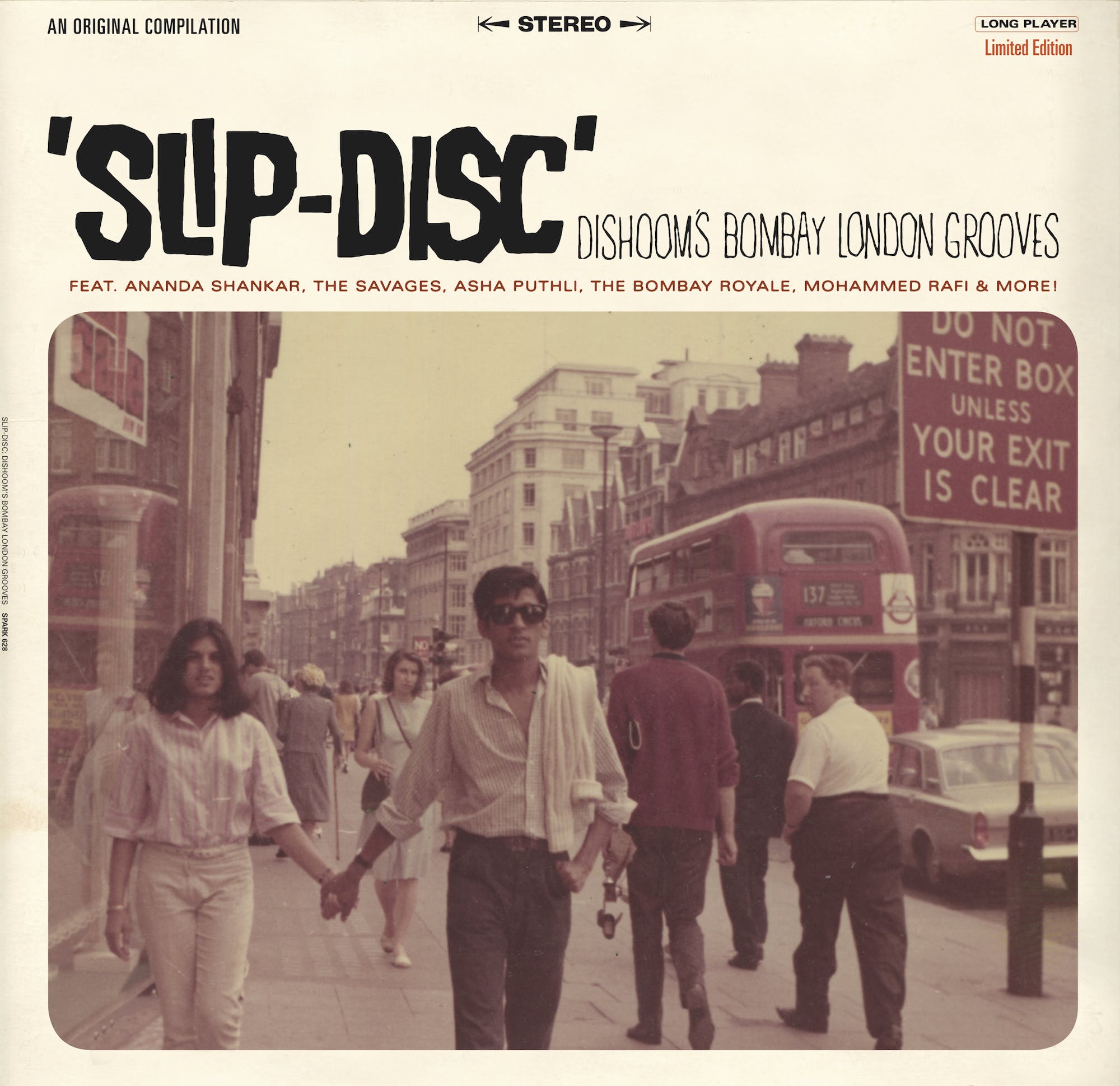
“Slip-Disc: Dishoom’s Bombay London Grooves” | Photo: Dishoom
ROBIN NANCE
Senior Manager Trade Engagement for Beam Suntory, Robin Nance has had a storied 30-year career in hospitality and brings all of that varied experience to her work by curating and building programming that addresses positive change, equity and inclusion. She is definitely a challenger of the status quo, changing, innovating and connecting with people to pay it forward. Robin is an idea woman, the bigger the better. In addition to The Blend, Robin is also working with Chicago’s City Colleges to develop the U.S.’ first Beverage Management pathway, launching in the fall of 2021.
V/A – “Slip-Disc: Dishoom’s Bombay London Grooves” [Honey Half-Fry Records, 2015]
“I chose this record for a couple of reasons. First, it is by far the most listened to record in our collection. My partner Jason and I have become huge fans of Indian and Indian-inspired music. The second reason requires a bit of a journey. Dishoom is a Bombay Café inspired restaurant, based out of London, with 8 UK locations. Slip-Disc is a compilation of the music that plays at Dishoom and you can only buy it there (or through their website).
In April of 2017, I flew to Edinburgh to attend Tales (of the Cocktail) On Tour. Upon arrival in Edinburgh, a couple of friends invited me to lunch at Dishoom (we were all first-timers) and we all fell in love instantly. We ate there every day of the week we were in town. One of those friends was Rocky Yeh. Rocky and I met at Dishoom every morning to work and oftentimes remained through lunch. We would sit there quietly, together, and type away on our computers while enjoying the menu and never less than three drinks. Usually a tea, a sparkling water, and some other concoction with or without alcohol. Sometimes we would chat or bounce ideas off each other, but mostly we just basked in togetherness. We rarely got this kind of uninterrupted time together as we usually saw each other at large cocktail events and both had hectic schedules. But for some reason, this trip had a light schedule that allowed us to have this extensive time. Rocky left this world at the end of 2019. I am eternally grateful for that trip and cherish those memories. This album transports me back.”
A-Side: Chai-ball
- Chai-ball
- 1 oz Auchentoshan American Oak
- ½ oz chai syrup*
- Add both to highball glass, add ice and top with East Imperial Yuzu Tonic.
- *To make chai syrup: Brew chai tea (2 bags per 8 oz water). Mix with demerara sugar 1:1 (8 oz chai + 1 cup sugar), let cool.
“You can also enjoy this as a non-alcoholic beverage!”
B-Side: Café Cooler
- 1½ oz Sipsmith London Dry Gin
- 3 oz Mango Lassi (“I used store bought”)
- ½ oz lemon juice
- Shake and strain over ice
- Top with tonic and garnish with fresh grated nutmeg
“I want to take a moment and acknowledge the brutal history of British rule in India. Choosing this record and the corresponding cocktails included deeper research and learning about this history. I hope to honor the heritage of Indian food and culture while also honoring my friend, who was a great educator in cultural appreciation of food and drink.”
Nonprofit: “Restaurant Workers’ Community Foundation envisions a hospitality industry in which employees are not costs to be minimized but essential partners in creating prosperity for all. There will be a transformation of the hospitality industry when it builds businesses based on a foundation of equity, respect and sustainable wages (that allow all workers to pay their living expenses and save for the future) – workplaces where people of every gender, race and immigration status are nurtured and have viable career paths toward greater fulfillment, where there is compassion and support for people experiencing mental health and substance use disorders, and where workers are free of harassment and sexual violence.”

